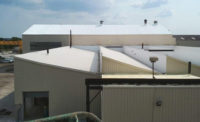Resilient Roofing in the Face of Intensifying Hurricanes and Storms

The 2017 Atlantic Hurricane Season included Hurricane Maria’s decimation of Puerto Rico; Maria and Irma’s extensive damage in the Virgin Islands; and Hurricane Harvey’s destruction to Texas, Louisiana and the Tennessee and Ohio Valleys. In September 2018, the Southeast was hit with Hurricane Florence, which caused catastrophic damage and deaths in the Florida panhandle and the Carolinas, primarily as a result of freshwater flooding. And, more recently, 2019’s Hurricane Dorian became the most intense tropical cyclone and worst natural disaster to strike the Bahamas to date. Estimated damage as a product of these storms alone is estimated to be in the billions of dollars.
In the face of increasingly disastrous hurricanes, durable and resilient construction is more important than ever. As professionals in the industry, we know roofing materials used in both new and retrofit construction play a huge role in a structure’s ability to withstand intense storms and hurricanes. We now have to do a better job to ensure our customers — whether homeowner, business owner or other — understand the importance of building for resiliency with storm resistant materials and help them make the right decisions. As professionals overseeing such an important part of the structure, we also need to pay very close attention to weather patterns in our regions to ensure we are recommending and using the best possible materials on our projects.
Wind and water resistance are two primary performance characteristics that are imperative for roofs located in hurricane-prone regions such as the Southeast, Gulf Coast and Puerto Rico.
Spray polyurethane foam roofing is an ideal solution in these regions. The material’s adhesion qualities make it particularly ideal in climate zones prone to severe weather cycling, storms, wind, hail and other conditions which frequently cause damage. The 2.8-lb. foam forms a durable, monolithic membrane over the roof and offers a compressive strength of approximately 40 to 55 lbs. per square inch. Spray foam roofing also changes little with time, and when properly maintained, lasts 30 years or more.
Most importantly, closed cell spray foam increases wind uplift resistance when installed to the roof substrate. When it’s applied to concrete, wind uplift resistance is even stronger. The material also resists peeling failure — a result of wind pulling flashings and copings away from a roof’s edges, which can ultimately lead to devastating damage to the structure. Closed cell SPF is also impermeable to moisture and may be cleaned and dried, which are key factors in it being classified as a flood damage resistant material by the Federal Emergency Management Agency. SPF’s ability to withstand leaks due to hail is also unsurpassed.
The National Institute of Standards and Technology (NIST) reviewed roof damage following Hurricane Katrina and discovered that buildings roofed with spray foam performed well without blow-off of the SPF or damage to flashings. NIST’s 2006 “Performance of Physical Structures in Hurricane Katrina and Hurricane Rita: A Reconnaissance Report” report found only one of the examined SPF roofs incurred notable damage and concluded that spray foam kept the roofs intact, prevented moisture from entering the buildings, and protected the structures from hail and debris.
While intensifying storms and hurricanes pose serious risks to homes and commercial structures, it’s more important than ever that these risks are properly addressed through smart material choices and construction methods. This will help ensure that the work we do daily better protects the safety of families, workers and end users, as well as the lifespan, stability and effectiveness of the properties we roof.
Looking for a reprint of this article?
From high-res PDFs to custom plaques, order your copy today!





